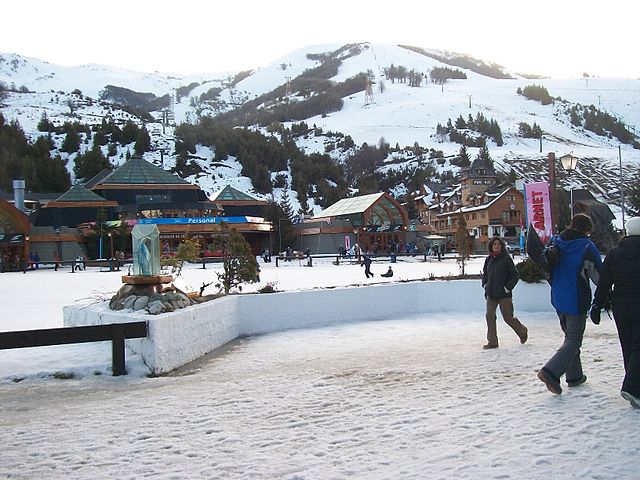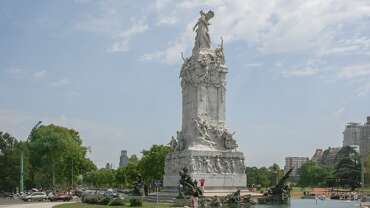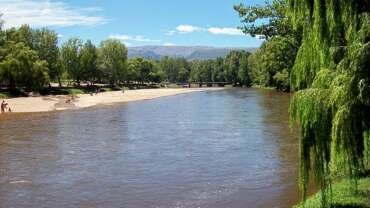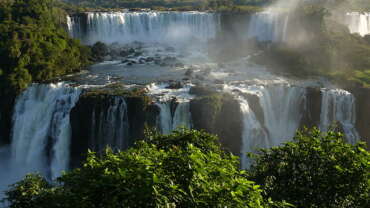Buenos Aires
Coming to Buenos Aires means opening the door to know and fall in love with one of the largest and most cosmopolitan capital cities in South America – the Autonomous City of Buenos Aires. With the Obelisco as one of its main icons, the city offers multiple options and spaces to visit. From modern avenues to beautiful parks and green spaces; buildings and monuments that are national historic heritage (Plaza de Mayo, the Pink House, the Cabildo, the National Congress, the Colón Theater, among others). But it is well worth going into the heart of the city to feel its most passionate tradition – tango. San Telmo, La Boca and Caminito are some of the must-see places. Or a walk along those districts that set the trend: Palermo, Recoleta and Puerto Madero.
As the main economic and social hub in the country, the city is always active. It gathers all kinds of activities (businesses, meetings, conventions) and gets crowds together as the seat of big cultural and sports events.
A few minutes away (60 km by highway), there is La Plata, capital city of the Province of Buenos Aires, and also known as the “city of diagonals”, due to its singular urban design, where the Neo-Gothic Cathedral and the Museum of Natural Science stand out, among other ideal places to visit with the family. La Plata is also the place of residence for many young students who come from all over the country lured by its varied university life.
The Atlantic coast has more than 1,200 km of beaches, where thousands of Argentine people and tourists rest and spend their summer vacation. Mar del Plata is the main city of all the beaches in the country, apart from being a destination for meetings and conventions tourism. There are the most traditional beaches for families such as Necochea, Monte Hermoso, Villa Gesell, Miramar, and those of the Partido de la Costa (Coast District); and more modern and exclusive ones, such as Pinamar and Cariló.
Look here for other touristic sites that you can visit in the province of Buenos Aires, such as Tandil, Sierra de la Ventana and rural areas and villages with gaucho’s tradition such as San Antonio de Areco, Luján, Carlos Keen, Tomás Jofré, Mercedes, among others.
Litoral Region
The Litoral region covers six provinces in the northeast of Argentina, places that impress by their fascinating natural world, which are a great international tourist attraction as well as a highly relevant place for the planet and the development of the eco-system in balance.
Misiones is the setting of tropical jungle, red soil and fabulous waterfalls that compose the Iguazú National Park. Its wealth and exceptional worth make this place a natural resource valued as World Heritage by UNESCO. In addition, it attracts international tourists’ attention because of the exceptional beauty of the Iguazú Waterfalls, considered one of the Seven Wonders of the World. In the province of Misiones, another world bastion converges – the Jesuit-Guarani Ruins, World Cultural Historical Heritage.
Corrientes has formidable natural wealth in Esteros del Iberá (Estuaries), which constitute the second most important wetland in South America. Also known as the “Argentine marshland”, it is amazing because of the biodiversity of flora and fauna, which is the habitat of species such as broad-snouted caiman, marsh deer, and hundreds of bird species.
Chaco where “El Impenetrable” is one of the most impressive treasures of its geography, the habitat to species such as the anteater, tapir, among others, make this National Park a place of eco-touristic reference internationally.
Formosa is the province of long rivers, estuaries, streams and jungles, where you can gaze at a diversity of birds and exotic fauna. It is worth visiting “El Bañado La Estrella”, one of the ideal places to enjoy contact with nature.
Entre Ríos amazes with its thermal complexes, resorts and beaches with important rivers such as Paraná and Uruguay, as well as different eco-tourism offers in El Palmar National Park, those related with agro-tourism and, in summer, it attracts with the colors of carnival such as Gualeguaychú.
Santa Fe makes you fall in love with its urban attractions such as active tourism in the riverside of Parana River. As a complement, the countryside and its estates are ideal places for rural tourism, and visiting the Milk Route. Another highlight for eco-tourism is Jaaukanigás, where you can find the largest RAMSAR site in the country, and provides a broad variety of circuits and options for bird watching, photographic safaris, kayak excursions and more.
Norte Region
This region in Argentina is integrated by six provinces located in the northwest of the territory: Jujuy, Salta, Catamarca, Santiago del Estero, Tucumán and La Rioja.
It shows, above all, a geography of outstanding contrasts, extraordinary beautiful landscapes and cultural wealth. The aridity of Puna; the lush jungle of the Yungas; Santiago del Estero plains almost at sea level, and the range of Andes Mountains of more than 6,800 m, landscapes that are the frame of ancient ruins, fortresses from the Incan period, colonial chapels, cathedrals and basilicas.
The colors of the Quebrada (canyon), the Valles Calchaquíes (valleys), the Train to the Clouds, the salt flats, the hot springs, the folklore, the typical dishes and high-altitude Torrontés wine are some of the various options that you can enjoy in the northwest of Argentina.
The legacy of original and Pre-Columbian peoples; or their relevant archaeological and paleontological findings are very interesting attractions to visit. The villages in the Quebrada de Humahuaca and the Valles Calchaquíes, the Camino del Inca (Incan Path), and the Camino Real (Royal Path), historical places, citadels and pucarás are some of the possibilities to go deeper into the northern culture.
The colors of the hills are expressed in every original piece, ponchos and woven items that you can get in their crafts route. Folklore is passed on from one generation to the next, and you can listen to zambas and chacareras in peñas and festivals. Carnivals, Pachamama (Mother Earth) festivities, Inti Raymi and misachicos invite you to celebrate with the local communities in their most intimate traditions.
Patagonia Region
Mythical Patagonia treasures amazing natural sceneries. It is located in the south of Argentina and it is constituted by the provinces of La Pampa, Neuquén, Río Negro, La Pampa, Chubut, Santa Cruz and Tierra del Fuego, Antarctica and South Atlantic Islands.
Among its beautiful landscapes and great attractions, five World Heritage (UNESCO) sites stand out – Los Glaciares National Park, Cueva de las Manos (Hands Cave), Los Alerces National Park and Valdés Peninsula.
On one of its sides, the range of the Andes Mountains stands out from north to south as one of its natural borders and opens impressive landscapes. Volcanoes’ summits with geyser and hot springs; mountains from which huge glaciers, lakes and rivers descend. Charming valleys and mountain villages surrounded by millenary native forests or large steppe fields.
Patagonia also causes amazement with its wild fauna and biodiversity which is also impressive. From maras, rheas, guanacos, and red deer to condors hovering from the Andes to the hills by the sea. It is also a habitat for a rich sea world, where lots of species form colonies of sea lions and elephant seals, Magellanic penguins, dolphins, toninas, and other species that arrive depending on the season, out of which the southern right whale (Natural Monument) stands out.
Cordoba Region
From the center of the country, Córdoba is one of the most developed provinces with the highest population following Buenos Aires. In its capital city with the same name, you will be able to see an intense commercial life, with businesses, culture and universities, which make it a hub of outstanding gatherings, conferences and meetings throughout the year. Among them, we can mention the recent VIII International Congress of Spanish Language 2019.
Its main touristic center is Villa Carlos Paz, at the foot of San Roque Lake, and it is an ideal place for a getaway. The closeness to rivers, hills and the Cordoba spirit describe it as a unique place. In the summer season, the theater offer is one of its main attractions as well as the possibility to enjoy dams, fit for sailing and practicing water sports.
Traslasierra and the valleys of Punilla and Calamuchita, among other regions in Cordoba, are also highly recommended to stay close to nature, with its brooks and rivers in an environment of absolute peace.
The kid goat from Cordoba, cheese and sausages from Colonia Caroya are some of its gastronomic legends, as well as the typical products such as the alfajor. In Calamuchita valley, you can have the Central-European cuisine specialties along with craft beer produced in Villa General Belgrano, the town where the National Beer Festival is held, also known as the Argentine Oktoberfest.
It is also known for its unparalleled outdoor museums that are complemented by the important cultural legacy of places such as the estates, churches and museums, many of which integrate the Jesuit Block and Estates of Cordoba, declared World Cultural Heritage by UNESCO.
Cuyo Region
The Cuyo Region is located on the Andes Mountains and extends to the south of the Sierras Pampeanas (Pampa’s Hills), covering the provinces of Mendoza, San Juan and San Luis.
In the Andes mountain range, the Aconcagua Mount rises, with 6,959 m above sea level, which attracts and challenges adventurers from all over the world to reach the highest summit in America. There are also other mountains that stand out such as Tupungato, Mercedario and Cordón del Plata, which are ideal to practice Alpinism, mountain climbing and trekking. And in the winter centers in Mendoza, you will find the best ski snow trails in the region.
By the way, it is the same Mountain Range that invites you to take San Martin’s Route, which was the historical freedom expedition of General San Martín, and cross the Andes riding a horse in Mendoza and San Juan.
Cuyo also stands out for the Wine Route, as it concentrates the major wine production in the country and variety of grapes (Malbec, Chardonnay, Sauvignon Blanc, Chenin and Riesling, Bonarda, Merlot, Cabernet Sauvignon, Pinot and Syrah). And you can choose from a variety of wineries, more than one thousand, to visit – from small cellars at the foot of the Mountain Range, craft wineries, boutique wineries or industrial wineries. Other activities that are a must are taking part of a grape harvest, going on bike-tours or horse-riding tours among vineyards and visiting their theme museums.
In Cuyo, you can visit more than twenty natural areas, some of which are great attractions for scientific and paleontological tourism. Among its most outstanding points, San Juan has El Leoncito National Park and Ischigualasto National Park. The latter is included as World Heritage (UNESCO). And in San Luis, Sierra de las Quijadas is another must-see place in the region.







